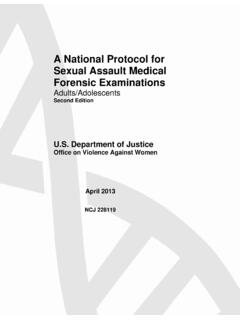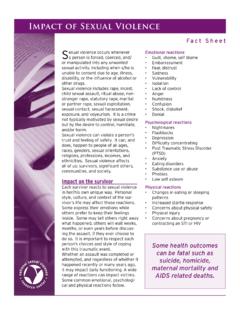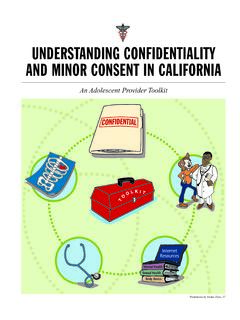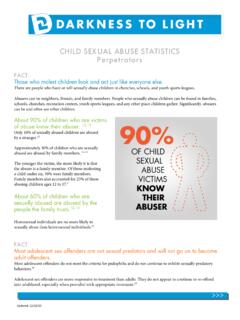Transcription of Experience of Violence in the Lives of Homeless Women
1 The author(s) shown below used Federal funds provided by the Department of Justice and prepared the following final report: Document Title: The Experience of Violence in the Lives of Homeless Women : A Research Report Author(s): Jana L. Jasinski; Jennifer K. Wesely; Elizabeth Mustaine; James D. Wright Document No.: 211976 Date Received: November 2005 Award Number: 2002-WG-BX-0013 This report has not been published by the Department of Justice. To provide better customer service, NCJRS has made this Federally-funded grant final report available electronically in addition to traditional paper copies. Opinions or points of view expressed are those of the author(s) and do not necessarily reflect the official position or policies of the Department of Justice. 1 The Experience of Violence in the Lives of Homeless Women : A Research Report1 Grant # 2002 WGBX0013 By Jana L.
2 Jasinski University of Central Florida Jennifer K. Wesely University of North Florida Elizabeth Mustaine University of Central Florida James D. Wright University of Central Florida September 2005 1 Final Report submitted to the National Institute of Justice, whose grant support made the research reported here possible. Not for citation, quotation or distribution without permission of the authors. Comments solicited. The views are those of the authors and do not purport to reflect the position of the National Institute of Justice or the United States Department of Justice. This document is a research report submitted to the Department of Justice. This report has not been published by the Department. Opinions or points of view expressed are those of the author(s) and do not necessarily reflect the official position or policies of the Department of Justice.
3 Abstract Studies investigating the Experience of Violence by Homeless Women date to the mid 1980 s, but most prior research has been more concerned with establishing the face of Violence committed against these extremely vulnerable Women than in exploring the risk factors responsible for it. This multi-site statewide study examined the Experience of Violence among 800 Homeless Women living in one of four cities in Florida and a comparison sample of approximately 100 men. A significant number of Women were victimized in their lifetime, and almost one-quarter of the Women indicated that Violence was one, if not the main reason they were Homeless . In fact almost one third of the sample of Women indicated they had left a childhood home due to Violence . Rates of sexual , physical and stalking victimization were much higher in this sample compared to the National Violence Against Women Survey, which used the same measures.
4 For the Women in this study, childhood experiences of Violence were consistently associated with negative outcomes such as alcohol and drug use, depression, and low self-esteem. Moreover, the results of the multivariate analysis indicated that childhood Violence significantly increased the risk for adult victimization net of all other factors in the model. In addition, other risk factors included current alcohol use, being divorced or separated, a greater number of children, number of times Homeless , and depression. What this analysis tells us is that Homeless Women are a vulnerable population with childhood Violence at the crux of this vulnerability. Minor and Severe Violence experienced as a child increased the risk of many of factors (including homelessness) that then were associated with a greater risk for adult victimization.
5 At a minimum, these results suggest that that more attention should be paid to the treatment of child victimization and a greater effort should be made to prevent child maltreatment. For the Women in our study, these efforts would be too late, however, Homeless shelters, may not be equipped to handle the myriad of problems that these Women may be dealing with. Shelters, for example appear to be more equipped to handle needs such as healthcare and the immediate issue of housing. However, they may not be prepared to delve deep into the childhood experiences of the Women that arrive at their facilities. Without such abilities, Homeless Women are in danger of repeating the cycle over and over again and putting both themselves and their children in grave danger. This document is a research report submitted to the Department of Justice.
6 This report has not been published by the Department. Opinions or points of view expressed are those of the author(s) and do not necessarily reflect the official position or policies of the Department of Justice. 2 Executive Summary There is no doubt that homelessness is a serious social problem in the United States, yet there is relatively little information describing the experiences of Violence among this population. Moreover, there is little research that uses standardized measurements of victimization types to compare them with samples of individuals who are not Homeless . The Florida Four-City Study was designed to overcome many of the limitations of existing research on victimization of Homeless individuals. Altogether, 737 Women were interviewed. In Orlando, 199 Women were interviewed at the Orlando Coalition for the Homeless .
7 In Tampa, 200 Women were interviewed at the Metropolitan Ministries facilities. At the Sulzbacher Center for the Homeless in Jacksonville, 146 Women were interviewed and in Miami 192 Women were interviewed at the Community Partnership for Homeless Inc. In addition, 91 face-to-face interviews with Homeless men in Orlando (but not in the other cities) were also conducted. The primary goal of this study was to develop an understanding of the role of Violence in the Lives of Homeless Women and men. The objectives are to determine how many Women and men have experienced some form of Violence in their Lives either as children or adults, factors associated with experiences of Violence , consequences of Violence , and types of interactions with the justice system. A summary of the findings is presented below. Major Findings Approximately one Homeless woman in four is Homeless mainly because of her experiences with Violence .
8 And while this is about half the more frequently cited guess of one in two, it nonetheless underscores the importance of Violence in the process by which some Women become Homeless . Homeless Women are far more likely to Experience Violence of all sorts than American Women in general, by differentials ranging from two to four depending on the specific type of Violence in question. Homeless men are also more likely to Experience Violence of all sorts than American men in general. At the zero order, Homeless men are more likely than Homeless Women to be victimized by assault (from any perpetrator) but this difference disappears when relevant confounds are controlled. Homeless Women are far more likely to be victims of intimate partner Violence than Homeless men are, and this difference is robust under statistical controls.
9 Homeless people of both genders are also frequent perpetrators of crime, although many of the crimes they commit are survival crimes or in some fashion drug-related. This study provides some evidence that true underlying rates of Violence against Homeless Women vary across cities, even netting out possible confounding factors, casting some doubt on inferences that can be made from single-site studies. This document is a research report submitted to the Department of Justice. This report has not been published by the Department. Opinions or points of view expressed are those of the author(s) and do not necessarily reflect the official position or policies of the Department of Justice. 3 One reason why the Experience of Violence is so common among Homeless Women is that their routine day-to-day activities expose them to potential offenders but do not provide them with capable guardians.
10 Sleeping patterns and routines are strongly related to victimization risks. By far the most significant risk factor for violent victimization as an adult is a pattern of physical, emotional and sexual abuse as a child. Indeed, it is apparent in both the quantitative and qualitative components of the study that many of the young girls destined to become Homeless adult Women have been permanently scarred by their childhood victimizations and have an extremely warped sense of what is normal and acceptable in their relationships with men. Victimized Homeless Women rarely report their victimization to the authorities and even when they do, satisfactory responses are infrequent. Establishing causal order in cross-sectional data is always tricky, but among the apparent consequences of Violence in the Lives of these Women are increased substance abuse, emotional distress, and lowered self esteem.

















